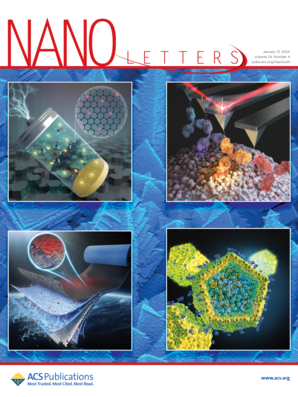同步调控缺s ZnS-MoS2异质结构纳米反应器快速持久储钠
IF 9.6
1区 材料科学
Q1 CHEMISTRY, MULTIDISCIPLINARY
引用次数: 0
摘要
电荷转移的增强和负极材料体积应力的减小有助于充分发挥钠离子存储的电化学性能。本文采用自组装和温度相关硫化工艺制备了硫空位含量可调的ZnS-MoS2异质结构(hp-ZMS-600/700/800)的中空碳多面体纳米反应器。密切的异质界面和适度的硫空位提供了快速的离子/电子转移通道,并且空心纳米反应器在钠化/脱氢过程中具有较大的体积变化并保持结构完整性。理论计算和原位/非原位表征技术揭示了优异的电子/离子扩散动力学和钠储存机制。结果表明,优化后的hp-ZMS-700钠离子电池阳极具有96.3%的初始库仑效率,0.1 a g-1时的高容量为398 mAh g-1, 5 a g-1时的高倍率容量为119.8 mAh g-1,在2 a g-1下循环1000次后的良好容量保持率为84.6%。本文章由计算机程序翻译,如有差异,请以英文原文为准。

Synchronous Regulation of S-Deficient ZnS-MoS2 Heterostructure Nanoreactor for Fast and Durable Sodium Storage
The enhancement of charge transfer and the relief of volume stress of anode materials contribute to fully exploiting electrochemical performance for sodium ion storage. Herein, a hollow carbon polyhedra nanoreactor adhered with a ZnS-MoS2 heterostructure with tunable sulfur vacancy content (denoted as hp-ZMS-600/700/800) is prepared by self-assembly and a temperature dependent sulfurization procedure. The intimate heterointerface and moderate sulfur vacancies provide fast ion/electron transfer channels, and the hollow nanoreactors afford large volume variation and maintain structural integrity during the sodiation/desodiation process. Theoretical calculations and in situ/ex situ characterization techniques reveal both excellent electron/ion diffusion dynamics and a sodium storage mechanism. As a result, the optimized hp-ZMS-700 anode in sodium-ion batteries delivers a high initial Coulombic efficiency of 96.3%, a high capacity of 398 mAh g–1 at 0.1 A g–1, good rate capability of 119.8 mAh g–1 at 5 A g–1, and an excellent capacity retention of 84.6% after 1000 cycles at 2 A g–1.
求助全文
通过发布文献求助,成功后即可免费获取论文全文。
去求助
来源期刊

Nano Letters
工程技术-材料科学:综合
CiteScore
16.80
自引率
2.80%
发文量
1182
审稿时长
1.4 months
期刊介绍:
Nano Letters serves as a dynamic platform for promptly disseminating original results in fundamental, applied, and emerging research across all facets of nanoscience and nanotechnology. A pivotal criterion for inclusion within Nano Letters is the convergence of at least two different areas or disciplines, ensuring a rich interdisciplinary scope. The journal is dedicated to fostering exploration in diverse areas, including:
- Experimental and theoretical findings on physical, chemical, and biological phenomena at the nanoscale
- Synthesis, characterization, and processing of organic, inorganic, polymer, and hybrid nanomaterials through physical, chemical, and biological methodologies
- Modeling and simulation of synthetic, assembly, and interaction processes
- Realization of integrated nanostructures and nano-engineered devices exhibiting advanced performance
- Applications of nanoscale materials in living and environmental systems
Nano Letters is committed to advancing and showcasing groundbreaking research that intersects various domains, fostering innovation and collaboration in the ever-evolving field of nanoscience and nanotechnology.
 求助内容:
求助内容: 应助结果提醒方式:
应助结果提醒方式:


